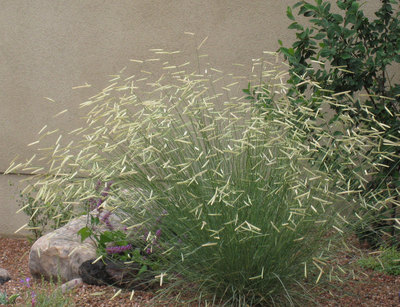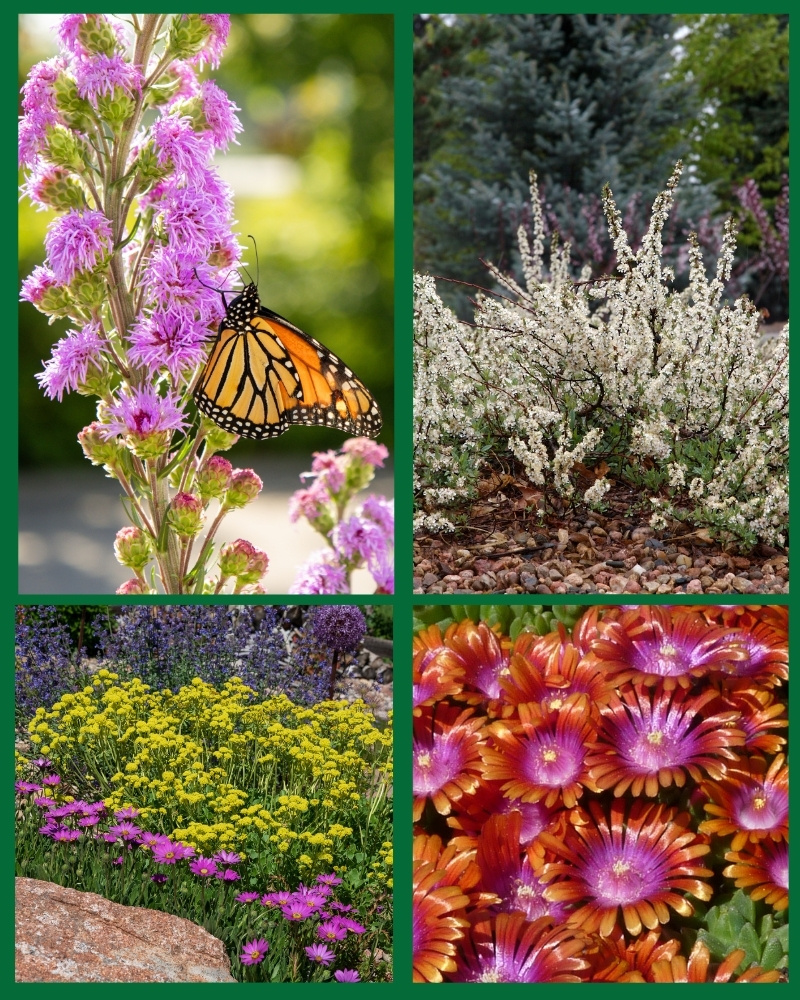Blue grama goes blonde (Bouteloua)

There’s a lot to be said for the grass called blue grama. It’s native to the short grass prairies of the Great Plains and to much of the intermountain region. It is a warm season bunch grass long known for its forage quality and as a low water, fine textured lawn for homeowners. Not until recently however has it been noted for its stand-alone unique appearance. That came to a head in 2007 with the discovery of an outstanding specimen growing within a stand of robust Hachita blue grama.
The discovery was made by David Salman of Santa Fe Greenhouses. He noticed this particular individual was taller than the standard, its leaves were a bright blue-green and it was topped with a multitude of its distinctive flag-like flowers, although these were chartreuse rather than the usual black or brown and they were held appealingly at a 90 degree angle to the leaves. It was apparent this was a plant that could stand on its own as an ornamental.
As the plant and its divisions went through trials, it was also discovered that the chartreuse flowers turned blonde as the season progressed and after it snowed and the snow melted away, the rigid stems of the plant popped back up rather than remaining prostrate. As a consequence its season of attractiveness lasted well into the winter. It seemed as though this tall blonde had ambition.
Being ambitious and a handsome blonde means its virtues really stand out when it mingles with other tall attractive grasses and late blooming perennials. David suggests big blue stem, little blue stem and possibly Indian grass to name a few. Perennials could include hyssops, purple coneflower varieties, Joe-Pye Weed and Russian Sage.
If you’d like to learn more about Blonde Ambition and the beauty of ornamental grasses, watch this video here featuring Dan Johnson, Denver Botanic Gardens.
View the plant profile here.
Blonde Ambition blue grama grass (Bouteloua gracilis ‘Blonde Ambition’ PP 22,048)
Perennial
Height: 28-32″
Width: 28-32″
Blooms: July to October
Sun: Full sun to partial shade
Soil Moisture: Moderate to xeric
Hardiness: USDA zones 4-9 (up to 8,000’)
Culture: Clay, loam or sandy soils
Thanks to David Winger, Winger Photography, for writing this piece. Photo courtesy of High Country Gardens.



I find it amazing how this plant can get beat down by heavy snow then pop back up again, even in the dead of winter.
Mine still looks beautiful, even in March. I don’t know how I ever lived without this plant!
[…] pale pink to white flowers—“Moroccan pincushion flower, ‘Granita™ Raspberry’ ice plant, ‘Blonde Ambition’ grass…,” Shrigley quickly ticks off other beauties, enthusing, “but there are WAY […]
Should this plant be cut back in March to 1-2″ tall? Or is it best not to trim it back?
I like to prune/shape this grass back only once per year. So I wait for March-April and trim it back to a mounded shape about 6 inches tall. Enjoy! R
What are some good plants to co-plant with the Blue Grama? I’m trying to get rid of more grass in my backyard and want to fill the space with native and low water plants. This plant is going to fill parts of my backyard that’s for sure!
May try some smaller or low growing shrubs: Autumn Amber sumac, Baby blue rabbitbrush, manzanitas and in the corners of the yard or in shady spots plant Bluestem joint fir and in between all of those plant masses of groundcovers like turquoise tails blue sedum or Winter Fire sedum, partridge feather and silverheels horehound, prairie zinnia, oh my gosh the possibilities are endless for no-water areas to replace lawns. Have fun & enjoy!
Where can these plants be purchased?
Try any one of these places or online. https://plantselect.org/where-to-buy/retailers/ Enjoy!
Planted four of these in the fall of 2023, #1 containers and had seed/flower stems. This year they’ve grown to full size, but not a single flower/seed stem. Only grass blades. Full sun. Cut back in early spring. On drip irrigation but gets some sprinkler over spray. Have you seen this behavior before? Hoping next year it’ll behave and put on more texture.
Give these plants a little more time. They will flower in the heat of the summer. They are warm season grasses. Great native plant!
They did take some time but are a real show now!